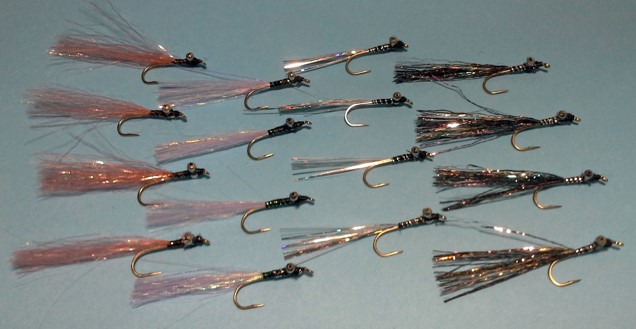Designed by Skip Morris, the Morrisfoam Predator was orignally developed as a trout fly, however it is equally effective as a trout fly.
While it is an effecitve top-water bug, it best fished on on a sinking line – the line finds the bottom while the fly (on an active retrieve) hovers just above the lake bed. How many patterns do you know of that are tied from buoyant, floating materials and then fished on a sinking line?
How to Fish
Use an 8 ½ foot 5 weight fly rod with a full sinking, density compensated line. Make a long cast parallel to shore. Let the Predator trail behind the slowly drifting canoe, or sometimes let it sit on the bottom while anchored. The buoyant fly will ride a foot or more off the bottom. It is an outstanding imitation of a dragon fly nymph, a key food for stillwater fishes.
Keep an eye on the rod, though! Takes on this fly are seldom subtle and you don’t want your fly rod heading over the gunnels of the boat! The rubber legs are always in motion and the fly is tossed about by the micro-currents in a very lifelike manner. Use a three to five foot length of 4lb test tippet material and tie the fly on using a non-slip mono loop knot for maximum life-like action.
Materials
- Hook – Gamakatsu F14 Large Dry Fly Hook, size 6 to 12
- Thread – Brown waxed (210 denier) – we use a larger thread to keep from cutting the foam
- Tail – Deer body hair, colour to match
- Body – Squirrel fur dubbing
- Shellback – Craft foam or furry foam, cut to a width not greater than the hook gape
- Eyes – Mono eyes, medium or large depending on hook size
- Head – Continuation of shellback foam
- Wing Case – Continuation of shellback foam
- Legs – Sili Legs or small diameter round rubber legs
Tying Instructions
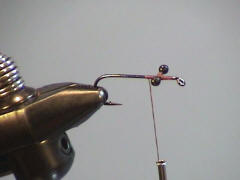
Step 1
Mount the hook in the vise and start your thread just behind the eye. Attach the mono eyes using a criss-cross wrap.
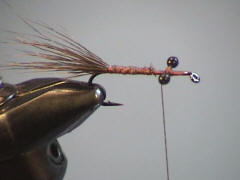
Step 2
Cut and clean a small bunch of deer body hair. Measure so the tail extends past the bend of the hook a distance not greater than the hook gape. Tie in the tail starting right behind the eyes. Use progressively looser wraps as you approach the bend of the hook to keep the hair from flaring.
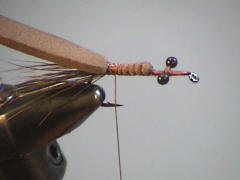
Step 3
Cut a piece of craft foam or furry foam so it is just slightly narrower than the gape of the hook. Select a piece about three inches long and tie in one hook eye length behind the mono eyes. Bind the foam to a point over the barb of the hook. Use easy tension to keep from cutting the foam with the thread.
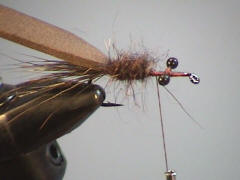
Step 4
Spin squirrel dubbing on the thread. Dub a fat body to the point where you tied in the foam.
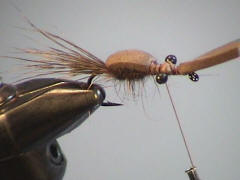
Step 5
Bring the foam over the top of the body as a shell back. Using the tying thread, secure the foam over the tops of the mono eyes and compress the foam to make a sturdy foundation for the head of the fly.
Step 6
Dub a head for the fly around the eyes. You can use a darker colour of dubbing, or the same colour, depending on the effect you want to achieve. The head should be slightly smaller in diameter than the dubbed body.
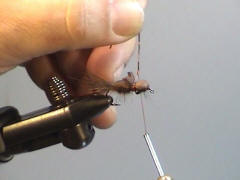
Step 7
Pull the foam back over the dubbed head of the fly and secure with a waist of tying thread behind the eyes. Don’t use too much pressure on the tying thread; you don’t want to cut the foam. Use several wraps in order to make clean separation between the abdomen and the head.
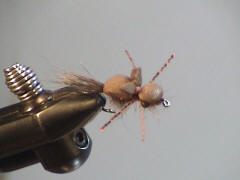
Step 8
Tie in a pair of legs on each side of the fly. Use the “loop over” method of attaching the rubber or silicone legs. Trim the legs to length.

Step 9
Whip finish using a hand whip technique. Finish the thread at the leg tie-in point. You can add a bit of super glue or head cement to seal the thread in place.





